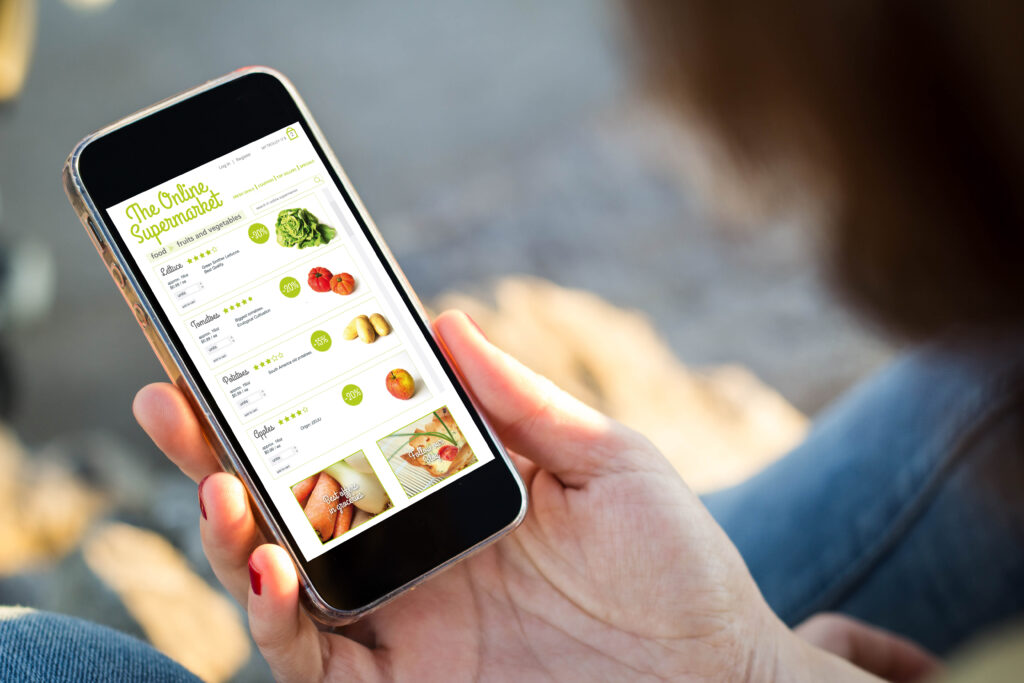
- Products
- Solutions
- Learn
- Partner
- Try Now
Online Grocery delivery is undergoing a significant transformation, shifting from traditional brick and mortar stores to the convenience of click and order online platforms. This transition is largely driven by evolving consumer preferences, technological advancements, and the convenience offered by online grocery delivery services.
Let’s delve into the key factors influencing this shift and explore the changing landscape.
The Rise of Online Grocery Delivery
Market Growth
- Global online grocery market size: Estimated at $419.63 billion in 2021 and projected to reach $2,160.7 billion by 2030 at a CAGR of 19.97%.
- US online grocery market: Expected to reach $209.28 billion by 2026, with a CAGR of 24.8%
- Global online grocery users: Projected to reach 1.4 billion in 2024, up from 547 million in 2018.
Consumer Behavior
Frequency of online grocery delivery:
- 62% of consumers who have bought groceries online intend to continue post-pandemic.
- 45% of online grocery shoppers cite convenience as the main driver.
- 60% of US online grocery shoppers use the same retailer for all their purchases.

Consumer Trends Shaping the Future
Omnichannel Experience
Consumers are increasingly using a blend of online and offline channels for grocery shopping. They might order staples online for home delivery and prefer to pick up fresh produce or browse specialty items at physical stores.
Personalized Shopping
Consumers are looking for personalized experiences, and online grocery platforms are utilizing data to offer:
- Recommendation engines: Suggesting products based on past purchases and browsing history.
- Subscription services: Delivering curated boxes of groceries or meal kits.
- Loyalty programs: Providing rewards and discounts for regular users.

Focus on Sustainability
Consumers are becoming more conscious of the environmental impact of their choices, and grocery retailers are responding by:
- Offering eco-friendly packaging options.
- Sourcing from local and sustainable farms.
- Partnering with companies offering carbon-neutral deliveries.
Technological Advancements
- Integration of advanced technologies like artificial intelligence (AI) and machine learning (ML) in online grocery platforms enhances personalized recommendations, making the shopping experience more tailored to individual preferences.
- The use of mobile apps, smart devices, and IoT (Internet of Things) in the grocery sector streamlines the shopping process and improves overall efficiency.
Expansion of Delivery Options
- The evolution of last-mile delivery solutions, including same-day or next-day delivery options, is becoming increasingly common. Companies are investing in logistics and infrastructure to meet customer expectations for quick and reliable service.
- Subscription-based models and loyalty programs offer incentives for customers to regularly use online grocery services.
Also read: Evolution of food delivery services
Partnerships and Mergers
- Traditional grocery retailers are recognizing the shift and forming strategic partnerships or mergers with e-commerce giants to stay competitive. For example, partnerships between traditional grocery chains and delivery platforms have become more prevalent.
- Amazon’s acquisition of Whole Foods in 2017 is a notable example of a tech giant entering the brick-and-mortar grocery space, leveraging its e-commerce expertise.
Challenges and Solutions
- Despite the growth of online grocery shopping, challenges such as the need for efficient logistics, maintaining product freshness, and addressing environmental concerns related to packaging persist.
- Innovative solutions, including sustainable packaging, optimized supply chain management, and the use of electric vehicles for deliveries, are being implemented to address these challenges.
Emergence of Automated Stores
Some companies are experimenting with automated or cashier-less stores, where customers can grab items and leave without going through a traditional checkout process. This further streamlines the shopping experience and aligns with the trend toward frictionless transactions.
Data-driven Personalization
The collection and analysis of customer data enable online grocery platforms to offer highly personalized recommendations, promotions, and discounts. This data-driven approach enhances customer engagement and loyalty.
Conclusion
In conclusion, the future of grocery delivery is undoubtedly shifting towards online platforms, driven by changing consumer preferences, technological innovations, and the need for increased convenience.
As the industry continues to evolve, stakeholders need to adapt to these changes, leveraging technology and strategic partnerships to meet the demands of the modern consumer.
Also Watch: Our latest theme to boost your Grocery Delivery business
Subscribe to stay ahead with the latest updates and entrepreneurial insights!

Subscribe to our newsletter
Get access to the latest industry & product insights.





















